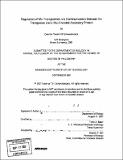Regulation of Mu transposition via communication between the transposase and Mu-encoded accessory protein
Author(s)
Schweidenback, Caterina Taiani Hill
DownloadFull printable version (11.32Mb)
Other Contributors
Massachusetts Institute of Technology. Dept. of Biology.
Advisor
Tania A. Baker.
Terms of use
Metadata
Show full item recordAbstract
Transposable elements comprise a significant portion of both prokaryotic and eukaryotic genomes. These mobile segments of DNA have helped to shape the course of evolution by generating genetic mutations and contributing to genomic rearrangements. Transposable elements often target transposition to non-random DNA sites. Ideal target sites must be common, so as to ensure efficient propagation of the transposable element, and yet non-essential, so as to protect the host cell on which the element depends. Transposable elements have devised a plethora of strategies for targeting transposition to desirable DNA. This thesis investigates the molecular mechanisms involved in Mu transposition. We explore the interactions between the Mu transposase, MuA, and a Mu-encoded accessory protein, MuB. Together, these two proteins regulate Mu transposition and targeting. We demonstrate that MuB interacts with multiple subunits of the MuA transposase complex to stimulate transposition. These results corroborate previous theories that MuB acts as an allosteric regulator of MuA. We also investigate the mechanism by which Mu transposes into selected DNA. We find that MuB "delivers" favorable target DNA to the Mu transposase by tethering the DNA to MuA. This interaction is independent of ATP hydrolysis by MuB. The work described herein has contributed to our understanding of the protein-protein interactions involved in Mu transposition.
Description
Thesis (Ph. D.)--Massachusetts Institute of Technology, Dept. of Biology, 2007. Includes bibliographical references.
Date issued
2007Department
Massachusetts Institute of Technology. Department of BiologyPublisher
Massachusetts Institute of Technology
Keywords
Biology.